Maps of Dust IR Emission for Use in Estimation of Reddening and CMBR Foregrounds
TL;DR: In this paper, the authors presented a reprocessed composite of the COBE/DIRBE and IRAS/ISSA maps, with the zodiacal foreground and confirmed point sources removed.
Abstract: We present a full sky 100 micron map that is a reprocessed composite of the COBE/DIRBE and IRAS/ISSA maps, with the zodiacal foreground and confirmed point sources removed. Before using the ISSA maps, we remove the remaining artifacts from the IRAS scan pattern. Using the DIRBE 100 micron and 240 micron data, we have constructed a map of the dust temperature, so that the 100 micron map can be converted to a map proportional to dust column density. The result of these manipulations is a map with DIRBE-quality calibration and IRAS resolution.
To generate the full sky dust maps, we must first remove zodiacal light contamination as well as a possible cosmic infrared background (CIB). This is done via a regression analysis of the 100 micron DIRBE map against the Leiden- Dwingeloo map of H_I emission, with corrections for the zodiacal light via a suitable expansion of the DIRBE 25 micron flux. For the 100 micron map, no significant CIB is detected. In the 140 micron and 240 micron maps, where the zodiacal contamination is weaker, we detect the CIB at surprisingly high flux levels of 32 \pm 13 nW/m^2/sr at 140 micron, and 17 \pm 4 nW/m^2/sr at 240 micron (95% confidence). This integrated flux is ~2 times that extrapolated from optical galaxies in the Hubble Deep Field.
The primary use of these maps is likely to be as a new estimator of Galactic extinction. We demonstrate that the new maps are twice as accurate as the older Burstein-Heiles estimates in regions of low and moderate reddening. These dust maps will also be useful for estimating millimeter emission that contaminates CMBR experiments and for estimating soft X-ray absorption.
Figures (15)
![FIG. 1.ÈThe 100 kmÈH I correlation with (a) no correction, (b) linear correction, and (c) quadratic correction for zodiacal contamination. The Ðts in the range [0, 200] K km s~1 are shown as solid lines.](/figures/fig-1-ethe-100-kmeh-i-correlation-with-a-no-correction-b-j2j6qo00.png)
FIG. 1.ÈThe 100 kmÈH I correlation with (a) no correction, (b) linear correction, and (c) quadratic correction for zodiacal contamination. The Ðts in the range [0, 200] K km s~1 are shown as solid lines. 
TABLE 2 
FIG. 13.ÈColor-color diagram for PSC sources. The diagonal line efficiently discriminates between galaxies (above the line) and stars (below the line). The square box is a strict color cut that retains 70% of stars. For clarity, only 1/10 of the stars are plotted. 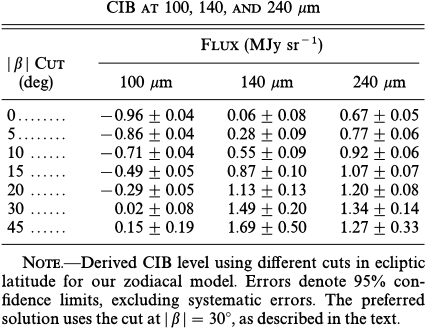
TABLE 3 ![FIG. 7.ÈSlice of sky from (a) the BH map, (b) the Leiden-Dwingeloo H I map, (c) our dust map with DIRBE resolution, and (d) our dust map with IRAS resolution. The slice measures approximately 90¡ ] 30¡, centered at l \ 100¡, b \ ]35¡.](/figures/fig-7-eslice-of-sky-from-a-the-bh-map-b-the-leiden-dwingeloo-1rzt4l41.png)
FIG. 7.ÈSlice of sky from (a) the BH map, (b) the Leiden-Dwingeloo H I map, (c) our dust map with DIRBE resolution, and (d) our dust map with IRAS resolution. The slice measures approximately 90¡ ] 30¡, centered at l \ 100¡, b \ ]35¡. 
FIG. 2.ÈRatio of recovered vs. true column density of dust using a single-temperature Ðt to two components. A fraction of dust at tem-f Bperature is added to 18 K dust. The recovered column density is alwaysT Blower than the true column density, with contours spaced in units of 0.1. 
FIG. 4.ÈFourier destriping of plate 379. (a) Raw ISSA HCON-0 image ; (b) FFT with wavenumber 0 in center ; (c) destriped image ; (d) FFT of destriped image. Note that one of the bins contains less power than the others. These are modes in which power from HCON-3 has replaced power in the otherkhHCONs; however HCON-3 covers only half the plate, resulting in less power. 
FIG. 14.ÈContamination at 100 km from faint stars. The solid histogram represents the derived contamination at 100 km from stars with Ñuxes below our Ñux cut. The dotted histogram shows the Ñux from stars explicitly removed from the maps. 
TABLE 4 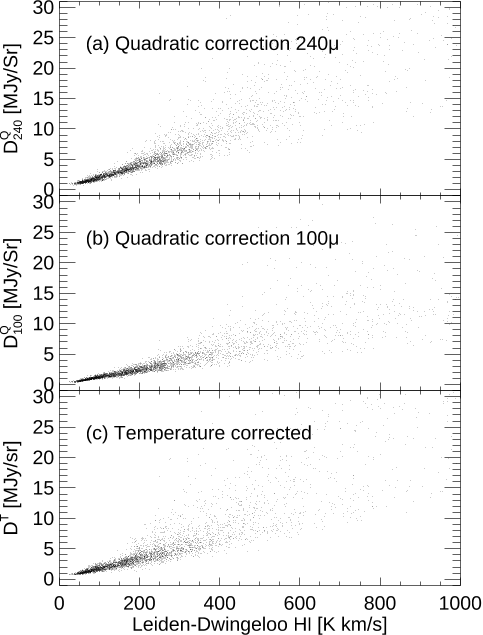
FIG. 10.ÈH I correlation with (a) DIRBE 240 km (corrected for zodiacal contamination), (b) DIRBE 100 km (also corrected), and (c) our derived dust column density. This plot demonstrates that the gas to dust relationship deteriorates at high Ñux levels. 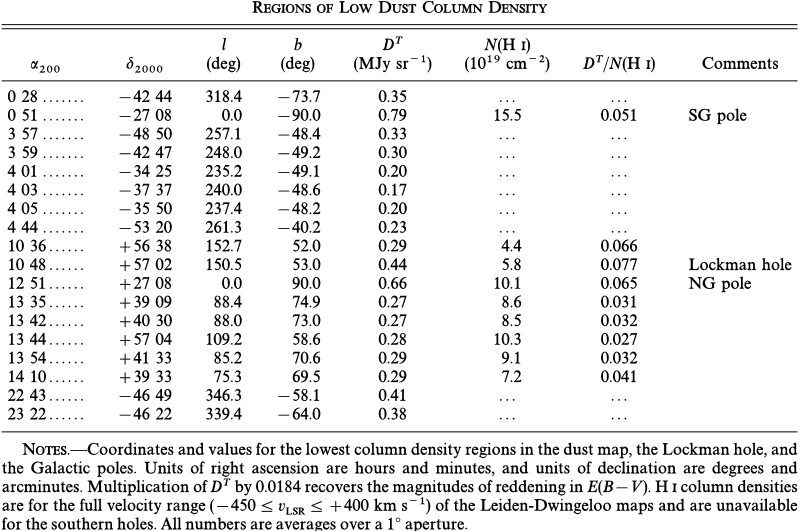
TABLE 5 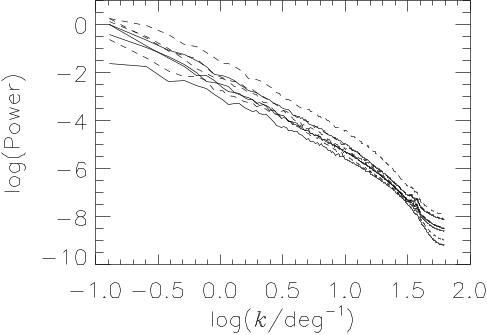
FIG. 9.ÈPower spectrum of dust. The four solid curves represent four quadrants in the north Galactic sky at b [ 45¡, while the four dashed curves represent four quadrants of the south Galactic sky. 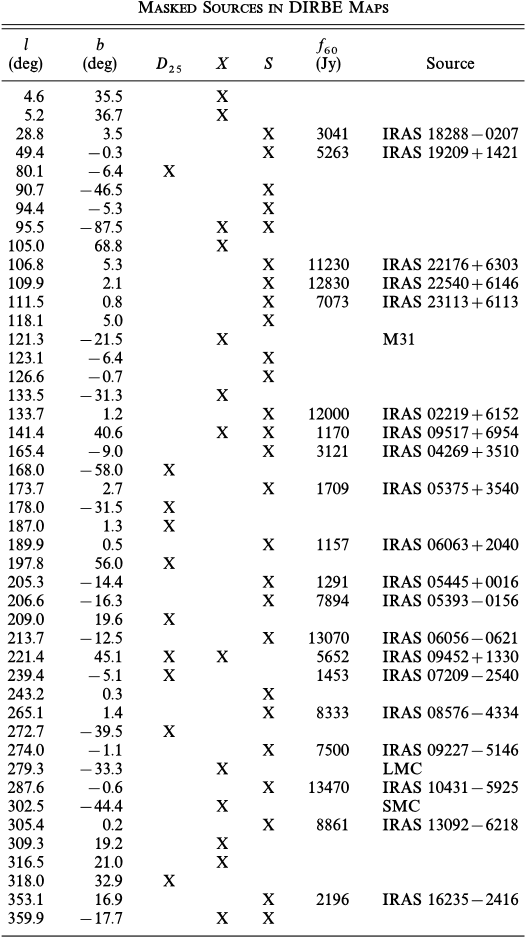
TABLE 1 
FIG. 6.ÈResiduals from the B[V vs. regression, plotted againstMg2foreground reddening, for (a) the BH maps and (b) the DIRBE/IRAS maps. Pluses represent galaxies at southern declinations where the BH maps lack dust-to-gas ratio information, and asterisks are those lacking any BH values. 
TABLE 6
Citations
More filters
TL;DR: In this paper, the authors present full sky microwave maps in five frequency bands (23 to 94 GHz) from the WMAP first year sky survey, which are consistent with the 7 in. full-width at half-maximum (FWHM) Cosmic Background Explorer (COBE) maps.
Abstract: We present full sky microwave maps in five frequency bands (23 to 94 GHz) from the WMAP first year sky survey. Calibration errors are less than 0.5% and the low systematic error level is well specified. The cosmic microwave background (CMB) is separated from the foregrounds using multifrequency data. The sky maps are consistent with the 7 in. full-width at half-maximum (FWHM) Cosmic Background Explorer (COBE) maps. We report more precise, but consistent, dipole and quadrupole values. The CMB anisotropy obeys Gaussian statistics with -58 less than f(sub NL) less than 134 (95% CL). The 2 less than or = l less than or = 900 anisotropy power spectrum is cosmic variance limited for l less than 354 with a signal-to-noise ratio greater than 1 per mode to l = 658. The temperature-polarization cross-power spectrum reveals both acoustic features and a large angle correlation from reionization. The optical depth of reionization is tau = 0.17 +/- 0.04, which implies a reionization epoch of t(sub r) = 180(sup +220, sub -80) Myr (95% CL) after the Big Bang at a redshift of z(sub r) = 20(sup +10, sub -9) (95% CL) for a range of ionization scenarios. This early reionization is incompatible with the presence of a significant warm dark matter density. A best-fit cosmological model to the CMB and other measures of large scale structure works remarkably well with only a few parameters. The age of the best-fit universe is t(sub 0) = 13.7 +/- 0.2 Gyr old. Decoupling was t(sub dec) = 379(sup +8, sub -7)kyr after the Big Bang at a redshift of z(sub dec) = 1089 +/- 1. The thickness of the decoupling surface was Delta(sub z(sub dec)) = 195 +/- 2. The matter density of the universe is Omega(sub m)h(sup 2) = 0.135(sup +0.008, sub -0.009) the baryon density is Omega(sub b)h(sup 2) = 0.0224 +/- 0.0009, and the total mass-energy of the universe is Omega(sub tot) = 1.02 +/- 0.02. There is progressively less fluctuation power on smaller scales, from WMAP to fine scale CMB measurements to galaxies and finally to the Ly-alpha forest. This is accounted for with a running spectral index, significant at the approx. 2(sigma) level. The spectral index of scalar fluctuations is fit as n(sub s) = 0.93 +/-0.03 at wavenumber k(sub o) = 0.05/Mpc ((sub eff) approx. = 700), with a slope of dn(sub s)/d I(sub nk) = -0.031(sup + 0.016, sub -0.018) in the best-fit model.
4,821 citations
TL;DR: The mass of supermassive black holes correlate almost perfectly with the velocity dispersions of their host bulges, Mbh ∝ σα, where α = 48 ± 05.
Abstract: The masses of supermassive black holes correlate almost perfectly with the velocity dispersions of their host bulges, Mbh ∝ σα, where α = 48 ± 05 The relation is much tighter than the relation between Mbh and bulge luminosity, with a scatter no larger than expected on the basis of measurement error alone Black hole masses recently estimated by Magorrian et al lie systematically above the Mbh-σ relation defined by more accurate mass estimates, some by as much as 2 orders of magnitude The tightness of the Mbh-σ relation implies a strong link between black hole formation and the properties of the stellar bulge
4,557 citations
Sloan Fellows1, University of Arizona2, New York University3, University of Pittsburgh4, University of Pennsylvania5, Massachusetts Institute of Technology6, Institute for Advanced Study7, University of Washington8, Fermilab9, Princeton University10, Apache Corporation11, Spanish National Research Council12, Eötvös Loránd University13, University of Tokyo14, University of Chicago15, Johns Hopkins University16, University of Colorado Boulder17, Space Telescope Science Institute18, University of Michigan19, University of Edinburgh20, Rochester Institute of Technology21, Lawrence Berkeley National Laboratory22, Pennsylvania State University23, Adler Planetarium24, University of Hawaii25
TL;DR: In this paper, a large-scale correlation function measured from a spectroscopic sample of 46,748 luminous red galaxies from the Sloan Digital Sky Survey is presented, which demonstrates the linear growth of structure by gravitational instability between z ≈ 1000 and the present and confirms a firm prediction of the standard cosmological theory.
Abstract: We present the large-scale correlation function measured from a spectroscopic sample of 46,748 luminous red galaxies from the Sloan Digital Sky Survey. The survey region covers 0.72h −3 Gpc 3 over 3816 square degrees and 0.16 < z < 0.47, making it the best sample yet for the study of large-scale structure. We find a well-detected peak in the correlation function at 100h −1 Mpc separation that is an excellent match to the predicted shape and location of the imprint of the recombination-epoch acoustic oscillations on the low-redshift clustering of matter. This detection demonstrates the linear growth of structure by gravitational instability between z ≈ 1000 and the present and confirms a firm prediction of the standard cosmological theory. The acoustic peak provides a standard ruler by which we can measure the ratio of the distances to z = 0.35 and z = 1089 to 4% fractional accuracy and the absolute distance to z = 0.35 to 5% accuracy. From the overall shape of the correlation function, we measure the matter density mh 2 to 8% and find agreement with the value from cosmic microwave background (CMB) anisotropies. Independent of the constraints provided by the CMB acoustic scale, we find m = 0.273 ±0.025+0.123(1+ w0)+0.137K. Including the CMB acoustic scale, we find that the spatial curvature is K = −0.010 ± 0.009 if the dark energy is a cosmological constant. More generally, our results provide a measurement of cosmological distance, and hence an argument for dark energy, based on a geometric method with the same simple physics as the microwave background anisotropies. The standard cosmological model convincingly passes these new and robust tests of its fundamental properties. Subject headings: cosmology: observations — large-scale structure of the universe — distance scale — cosmological parameters — cosmic microwave background — galaxies: elliptical and lenticular, cD
4,428 citations
TL;DR: For a flat universe with a cosmological constant, the transition between the two epochs is constrained to be at z = 0.46 ± 0.13 as mentioned in this paper, and w = -1.02 ± (and w < -0.76 at the 95% confidence level) for an assumed static equation of state of dark energy.
Abstract: We have discovered 16 Type Ia supernovae (SNe Ia) with the Hubble Space Telescope (HST) and have used them to provide the first conclusive evidence for cosmic deceleration that preceded the current epoch of cosmic acceleration. These objects, discovered during the course of the GOODS ACS Treasury program, include 6 of the 7 highest redshift SNe Ia known, all at z > 1.25, and populate the Hubble diagram in unexplored territory. The luminosity distances to these objects and to 170 previously reported SNe Ia have been determined using empirical relations between light-curve shape and luminosity. A purely kinematic interpretation of the SN Ia sample provides evidence at the greater than 99% confidence level for a transition from deceleration to acceleration or, similarly, strong evidence for a cosmic jerk. Using a simple model of the expansion history, the transition between the two epochs is constrained to be at z = 0.46 ± 0.13. The data are consistent with the cosmic concordance model of ΩM ≈ 0.3, ΩΛ ≈ 0.7 (χ = 1.06) and are inconsistent with a simple model of evolution or dust as an alternative to dark energy. For a flat universe with a cosmological constant, we measure ΩM = 0.29 ± (equivalently, ΩΛ = 0.71). When combined with external flat-universe constraints, including the cosmic microwave background and large-scale structure, we find w = -1.02 ± (and w < -0.76 at the 95% confidence level) for an assumed static equation of state of dark energy, P = wρc2. Joint constraints on both the recent equation of state of dark energy, w0, and its time evolution, dw/dz, are a factor of ~8 more precise than the first estimates and twice as precise as those without the SNe Ia discovered with HST. Our constraints are consistent with the static nature of and value of w expected for a cosmological constant (i.e., w0 = -1.0, dw/dz = 0) and are inconsistent with very rapid evolution of dark energy. We address consequences of evolving dark energy for the fate of the universe.
4,236 citations
TL;DR: In this paper, the relation between stellar mass and gas-phase metallicity was studied using the Sloan Digital Sky Survey imaging and spectroscopy of ~53,000 star-forming galaxies at z = 0.1.
Abstract: We utilize Sloan Digital Sky Survey imaging and spectroscopy of ~53,000 star-forming galaxies at z ~ 0.1 to study the relation between stellar mass and gas-phase metallicity. We derive gas-phase oxygen abundances and stellar masses using new techniques that make use of the latest stellar evolutionary synthesis and photoionization models. We find a tight (?0.1 dex) correlation between stellar mass and metallicity spanning over 3 orders of magnitude in stellar mass and a factor of 10 in metallicity. The relation is relatively steep from 108.5 to 1010.5 M? h, in good accord with known trends between luminosity and metallicity, but flattens above 1010.5 M?. We use indirect estimates of the gas mass based on the H? luminosity to compare our data to predictions from simple closed box chemical evolution models. We show that metal loss is strongly anticorrelated with baryonic mass, with low-mass dwarf galaxies being 5 times more metal depleted than L* galaxies at z ~ 0.1. Evidence for metal depletion is not confined to dwarf galaxies but is found in galaxies with masses as high as 1010 M?. We interpret this as strong evidence of both the ubiquity of galactic winds and their effectiveness in removing metals from galaxy potential wells.
3,621 citations